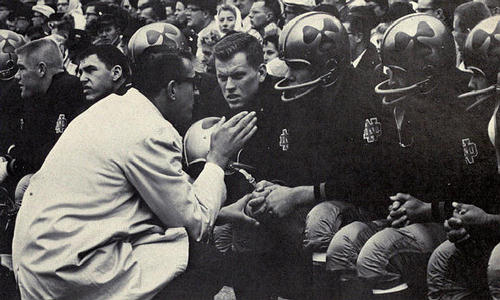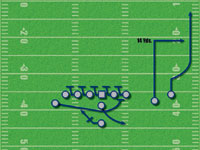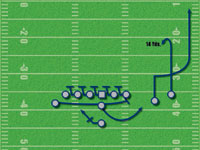Flying Irish | by J-DUB
(Tonight we're very pleased to have John Walters joining us as a guest blogger on BGS. "J-Dub", as you probably know, is a veteran sportswriter -- and Notre Dame grad -- who has written extensively for NBC Sports, Sports Illustrated, and other publications. I asked John if there was anything else bio-wise I should mention in my introduction, and he told me that he was also voted "3rd most affable" in his high school class, but that these days he is no longer nearly as affable. John's going to poke his head in here at BGS from time to time, so stay tuned. Please give him a hearty welcome. Take it away, John...)
When the New York Yankees won their first World Series under Joe Torre in 1996, the lede to the Sports Illustrated piece on their triumph began, "Destiny ends in 'NY'."
Twelve years later, after Southern California routed Notre Dame in the Los Angeles Coliseum, 38-3 (the nadir: Trojan fans give the Irish a standing ovation after ND records its initial first down on the final play of the 3rd quarter), you could have written, "Moribund ends in 'ND'."
Granted, the Trojans boasted a once-in-a-generation defense (possibly six future NFL first-rounders), but Notre Dame was held below 100 yards in total offense. Head coach Charlie Weis' future in South Bend seemed at best a coin flip. And the Irish had just ended the season having lost five of their last seven, the lone wins coming against winless Washington and a Navy squad who came within one play of redefining ignominy in South Bend.
But you know all that.
What happened next, however, provides a blueprint for how the Irish offense should operate in 2009. Notre Dame ventured to the sublime sands of Honolulu and pummeled Hawaii, 49-21. In doing so, they rediscovered who they are under Weis.
The Irish put up their greatest point total (49), greatest yardage total (478) and greatest passing offense total (413 yards) since Brady Quinn (heretofore BQQB) was directing the offense. Quarterback Jimmy Clausen stepped up to a new plateau completing nearly 88% of his passes (22 of 26) and throwing five touchdowns and no interceptions. Even more promising for the Irish, seven different receivers caught two or more passes. Not since Chuck Noland (i.e., Tom Hanks) met Wilson has a mainlander had such a ball, with a ball, on a tropical island while in the process discovering his true self.
 Notre Dame, under Charlie Weis, is a passing offense. And it should be. While Weis has paid lip service to having a balanced attack more times than, well, certainly more times than Asaph Schwaap ever carried the ball, the Irish would be better served if the pendulum swung even further in the direction of the passing game. Here are just a few reasons why:
Notre Dame, under Charlie Weis, is a passing offense. And it should be. While Weis has paid lip service to having a balanced attack more times than, well, certainly more times than Asaph Schwaap ever carried the ball, the Irish would be better served if the pendulum swung even further in the direction of the passing game. Here are just a few reasons why:1) You put your best weapons on the field, and the Irish have never had such an arsenal. Barring injury, the current corps of receivers at Notre Dame will be remembered as, without question, the most prolific group in school history. Last season Michael Floyd caught 48 passes -- despite missing three games due to injury -- beating the school record for freshmen by 50%. And the player whose record he topped, Duval Kamara (32 in '07) is only beginning his junior season this year. Tight end Kyle Rudolph caught 29 passes, which must be a record for a frosh tight end in South Bend since when does a freshman ever start at that position for the Irish?
Floyd, Kamara, Rudolph. All set freshman receiving records, none has yet to play as an upperclassmen and yet...and yet, none of the three are the team's top returning receiver. That would be Golden Tate, who caught 58 passes a year ago. Tate, besides being the team's deep threat, has the most magical hands since Derrick Mayes.
Jeff Samardzija, Notre Dame's all-time receptions leader (both career, 179, and single-season, 78) caught 24 passes his first two seasons in South Bend. Twenty-four, in two years. Floyd, Kamara and Rudolph all caught more passes as freshmen. And Tate, after two seasons, has 64 catches.
And I haven't even mentioned Armando Allen yet. The spry tailback caught 24 passes in his freshman year and has 74 catches in two seasons. In terms of career numbers, Allen is the Irish's top returning receiver.
2) Do the math. You need five offensive lineman. You need one passer. That leaves five other positions on the field. Who is going to help the Irish score points and move chains better than the five players--Floyd, Kamara, Rudolph, Tate and Allen--just mentioned? Steve Paskorz? If you were an opposing defensive coordinator, wouldn't you rather see anyone other than Tate or Allen with the ball in their hands coming out of the backfield?
3) Have you seen the opposition? Students of recent Irish gridiron history know just how seamlessly an offense transitions with a first-year starter at quarterback. Five of the first seven opponents on Notre Dame's 2009 itinerary -- Michigan, Michigan State, Purdue, USC and Boston College -- are essentially breaking in new starters under center.
Nevada, the home- and season-opener on Sept. 6, has an excellent and unorthodox offensive attack, but you'd have to believe that after last September's near-debacle versus San Diego State that the Irish will not come out flat (also, there's the burning desire to rinse the aftertaste from the last two games played at Notre Dame Stadium, come-from-ahead losses to Pitt and Syracuse). The other foe of the first seven with a returning starter is U-Dub and future first-rounder Jake Locker.
Anyway, what better defense to throw at such callow offensive attacks than an offense that races out to a 21-0 first-half lead? The 2009 Irish offense could, and should, resemble that of the 2005 group. And if that happens, the Irish defense can play from the vantage of a double-digit lead in the first half, which may compel opposing offenses to throw more than they might want to, which leads me point No. 4...
4) The Irish secondary. Clearly, for the second year in a row, the secondary will be the most formidable unit of the Irish defense. In cornerbacks Darrin Walls, Robert Blanton and Raeshon McNeil the Irish are stacked. Strong safety Kyle McCarthy led the Irish in tackles with 110 (and was the defense's most pleasant surprise) while Harrison Smith moves to his natural position of free safety. Smith, by the way, is the defense's leading returner in tackles (57) after McCarthy. The highly crankable Sergio Brown will play plenty at safety or nickel, as well, and demonstrated a knack for being a playmaker in '08.
Notre Dame's secondary is its primary defensive weapon. Putting opponents into passing mode plays right into what the Irish should want to do (ask Javon Ringer and LeSean McCoy).
5) How'd that short-yardage rush work, anyway? How many times do we need to see the Irish fail on a must-have short-yardage rush to know that they just don't roll that way? Travis Thomas on the final play against Navy in '07? The Irish had 2nd-and-goal at the 3 in the first overtime versus Pitt last October and lost a yard on a rush--on what seemed to be the exact same play, in nearly the exact same spot--by Armando Allen.
Asaph Schwapp, the primary fullback the past three years, was an incredibly hard-working and selfless fullback (the latter is by definition a job requirement at the position in the Weis era). In his final three seasons Schwapp had 17 carries for 31 yards.
There'll never be another Asaph Schwapp at Notre Dame. I mean, it's quite an original name. There may never be another Asaph Schwapp anywhere. But if the Irish find themselves facing 4th-and-inches in '09, I'd rather them line up five-wide and see what a little game of pitch-and-catch will yield.
You can knock Charlie Weis for a lot of things the past couple of years, but give him these few things: the man accepts the blame; when it comes to physical pain, he's no whiner; and he understands the passing game.
Three of the top four passing seasons in Irish history have taken place during the four years Weis has been at the helm in South Bend (2005, 330.3 ypg; 2006, 264.08 ypg, 2008, 245.4 ypg). The one non-Weis season of the top four was 1970, when Joe Theismann and Tom Gatewood led the Irish to a 252.7 yards per game average, the pre-Weis gold standard at the Golden Dome.
The one year that the Irish were subpar in the passing game was, of course, '07, when Weis was breaking eight to nine new starters on offense. We can grant him amnesty on that season, no?
Check out these numbers for the Irish's top three receivers, by season:
- 2005: Samardzija, Maurice Stovall and Anthony Fasano all have at least 47 receptions and as a trio total 193. The Irish finish "9-3 is not good enough".
- 2006: Samardzija, Rhema McKnight and Darius Walker all have at least 56 receptions and total 201 catches among the three. The Irish finish 10-3.
- 2008: Though the Irish stumble to a 7-6 mark, Golden Tate, Armando Allen and Michael Floyd all catch at least 48 passes and total 156 passes. The difference between '08 and the '05 and '06 seasons. The players mentioned in '05 and '06 were all upperclassmen catching passes thrown by an upperclassman QB throwing behind an experienced line. Tate, Allen and Floyd were all underclassmen catching passes thrown by an underclassman QB playing behind an inexperienced line.
What about Robert Hughes and James Aldridge and Jonas Gray (a.k.a., "the Jonas brother")? Surely, you cannot win without a solid rushing attack, right? After all, in all six of Notre Dame's losses last season the Irish failed to top 90 yards rushing (they gained 115 in the 4 OT loss to Pitt, but 25 after regulation). On the other hand ("On the other hand, you have different fingers..."), the Irish had only 65 yards rushing in the offensive explosion versus Hawaii.
There may be a cosmetic value to seeing a balanced offense, in terms of rushing and passing yards, on the stat sheet. However, if you think of the signature runs of the Weis era, those big gainers by Darius Walker or Armando Allen or Golden Tate, most have come on either swing passes or end-arounds. In fact, I'm happy to be corrected, but I believe the longest rush from scrimmage during the Weis era was undertaken by none other than BQQB (60 yards versus USC in '06).
Meanwhile, the Irish averaged 34.6 pass attempts per game in '05, 35.9 attempts in '06 and 33.8 attempts last season. Wouldn't you like to see what they might be able to accomplish averaging closer to 40 attempts per game in '09? And if that means bringing in Dayne Crist for a series or two each game, why not?
Two final thoughts:
• Not yet mentioned, though they should be: Robby Parris, Deion Walker and John Goodman are all talented. Laugh at me if you want, but with his size (6-4, 210) and hands I won't be surprised if Parris makes an NFL roster in 2010. Walker has size (6-2) and speed. And in the 20 minutes the media is afforded to watch the beginning of practice, I've always been impressed with the flat-out effort Goodman (who is 6-3) gives in every drill.
What I'd love to see in '09 is this trio working extensively with Dayne Crist (do you really believe for a moment that a healthy Clausen won't be starting against the Wolfpack?). And I'd love to see Weis bring them in as a unit for a series or two in each game. Although, Parris particularly belongs in the rotation every bit as much as Kamara (and, yes, I've neglected to mention George West, but he is at best the fifth-best wideout on this unit).
• If you look at the postseason awards the past two years you'll notice that no Notre Dame player has even been named as an honorable mention All-American. That drought ends in 2009. And if you had to pick a player who ends it, the nod here is that it will either be Clausen or someone on the receiving end of his throws.
And, finally, the SI writer who penned "Destiny ends in 'NY''"? That was Tom Verducci, whose older brother Frank is Notre Dame's new O-line coach.
 Tournaments are exhilirating for winners and neutral observers, but miserable for the favorites who get caught on a bad night. Only once since 1979 have all four #1 seeds played in the men's basketball Final Four. As teams like Arizona in 1993 and Syracuse (hee) in 1991 can attest, one off night can bring a fine season to a screeching halt.
Tournaments are exhilirating for winners and neutral observers, but miserable for the favorites who get caught on a bad night. Only once since 1979 have all four #1 seeds played in the men's basketball Final Four. As teams like Arizona in 1993 and Syracuse (hee) in 1991 can attest, one off night can bring a fine season to a screeching halt.
 It's springtime. Football, like life itself, is born anew. Five questions to ponder as we kick off camp, which starts today.
It's springtime. Football, like life itself, is born anew. Five questions to ponder as we kick off camp, which starts today. Harrison Smith is the favorite out of the gate, but with a very solid showing at the nickel through most of last year, Sergio Brown should make it interesting. Neither played more than a handful of downs last season at free safety so both will have to adjust to the new role and its responsibilities. The good news is that both guys are extremely athletic and would be able to do a solid job. It's a nice problem to have. The Irish are finally getting to the point where an open starting spot means a legitimate competition between qualified players, instead of someone backing into the job because there's no one else available.
Harrison Smith is the favorite out of the gate, but with a very solid showing at the nickel through most of last year, Sergio Brown should make it interesting. Neither played more than a handful of downs last season at free safety so both will have to adjust to the new role and its responsibilities. The good news is that both guys are extremely athletic and would be able to do a solid job. It's a nice problem to have. The Irish are finally getting to the point where an open starting spot means a legitimate competition between qualified players, instead of someone backing into the job because there's no one else available.

 Before we know it, spring practice will be over, beginning the Long Summer's Wait. Although now is too early to predict the Irish starting twenty-two, let alone guess the depth charts of every opponent, it's never too early to do a little advance scouting. There's no time like the present to meet our first opponent in 2009, the University of Nevada-Reno, and their innovative "Pistol" Offense.
Before we know it, spring practice will be over, beginning the Long Summer's Wait. Although now is too early to predict the Irish starting twenty-two, let alone guess the depth charts of every opponent, it's never too early to do a little advance scouting. There's no time like the present to meet our first opponent in 2009, the University of Nevada-Reno, and their innovative "Pistol" Offense.



 Earlier this week, new defensive line coach Randy Hart was formally introduced at Notre Dame. The longtime Washington assistant seems lively and spry, and should bring a lot of energy to the defense this year. Quoth Hart:
Earlier this week, new defensive line coach Randy Hart was formally introduced at Notre Dame. The longtime Washington assistant seems lively and spry, and should bring a lot of energy to the defense this year. Quoth Hart:
